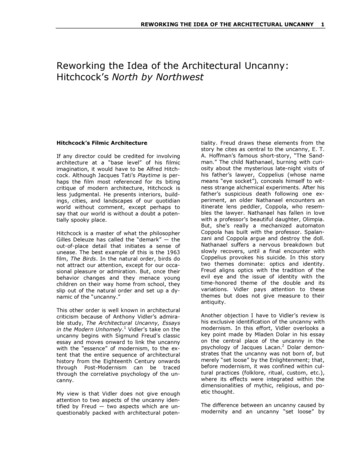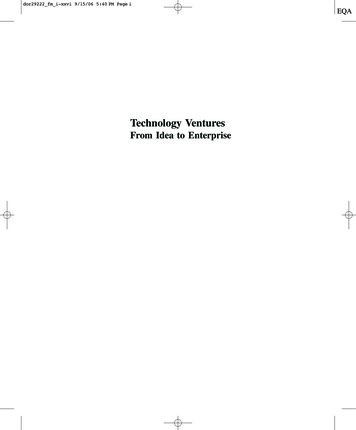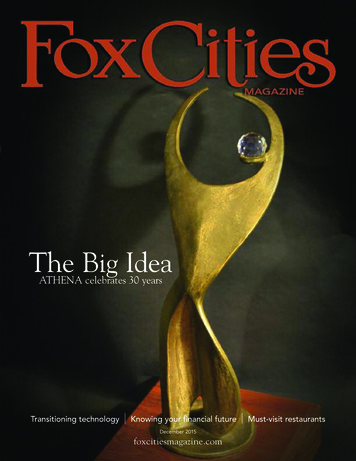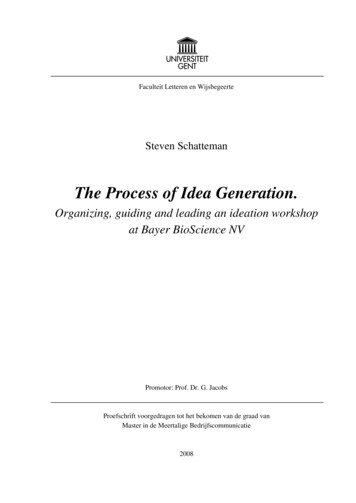
Transcription
REWORKING THE IDEA OF THE ARCHITECTURAL UNCANNY1Reworking the Idea of the Architectural Uncanny:Hitchcock’s North by NorthwestHitchcock’s Filmic ArchitectureIf any director could be credited for involvingarchitecture at a “base level” of his filmicimagination, it would have to be Alfred Hitchcock. Although Jacques Tati’s Playtime is perhaps the film most referenced for its bitingcritique of modern architecture, Hitchcock isless judgmental. He presents interiors, buildings, cities, and landscapes of our quotidianworld without comment, except perhaps tosay that our world is without a doubt a potentially spooky place.Hitchcock is a master of what the philosopherGilles Deleuze has called the “demark” — theout-of-place detail that initiates a sense ofunease. The best example of this is the 1963film, The Birds. In the natural order, birds donot attract our attention, except for our occasional pleasure or admiration. But, once theirbehavior changes and they menace youngchildren on their way home from school, theyslip out of the natural order and set up a dynamic of the “uncanny.”This other order is well known in architecturalcriticism because of Anthony Vidler’s admirable study, The Architectural Uncanny, Essaysin the Modern Unhomely.1 Vidler’s take on theuncanny begins with Sigmund Freud’s classicessay and moves onward to link the uncannywith the “essence” of modernism, to the extent that the entire sequence of architecturalhistory from the Eighteenth Century onwardsthrough Post-Modernism can be tracedthrough the correlative psychology of the uncanny.My view is that Vidler does not give enoughattention to two aspects of the uncanny identified by Freud — two aspects which are unquestionably packed with architectural poten-tiality. Freud draws these elements from thestory he cites as central to the uncanny, E. T.A. Hoffman’s famous short-story, “The Sandman.” The child Nathanael, burning with curiosity about the mysterious late-night visits ofhis father’s lawyer, Coppelius (whose namemeans “eye socket”), conceals himself to witness strange alchemical experiments. After hisfather’s suspicious death following one experiment, an older Nathanael encounters anitinerate lens peddler, Coppola, who resembles the lawyer. Nathanael has fallen in lovewith a professor’s beautiful daughter, Olimpia.But, she’s really a mechanized automatonCoppola has built with the professor. Spalanzani and Coppola argue and destroy the doll.Nathanael suffers a nervous breakdown butslowly recovers, until a final encounter withCoppelius provokes his suicide. In this storytwo themes dominate: optics and identity.Freud aligns optics with the tradition of theevil eye and the issue of identity with thetime-honored theme of the double and itsvariations. Vidler pays attention to thesethemes but does not give measure to theirantiquity.Another objection I have to Vidler’s review ishis exclusive identification of the uncanny withmodernism. In this effort, Vidler overlooks akey point made by Mladen Dolar in his essayon the central place of the uncanny in thepsychology of Jacques Lacan.2 Dolar demonstrates that the uncanny was not born of, butmerely “set loose” by the Enlightenment; that,before modernism, it was confined within cultural practices (folklore, ritual, custom, etc.),where its effects were integrated within thedimensionalities of mythic, religious, and poetic thought.The difference between an uncanny caused bymodernity and an uncanny “set loose” by
2modernity is considerable. First, we mightstudy the uncanny as a co-effect of Enlightenment practices, emphasizing the role of ourperception and reception of literature andother arts as newly receptive to “mechanisms”that were previously concealed by ideas of thesacred. For example, many have pointed outthat Gothic literature arises precisely at thetime of the French Revolution. The secularuncanny puts the subject in a state of psychological rather than a spiritual imbalance, andthe implications for human action are strikingly different. Here, the themes of optics andidentity are absolutely crucial.In its secularized form, the uncanny becomesa matter of design. Artists employ its tricks.Audiences laugh and enjoy rather than tremble or cower. In the modern uncanny, opticsand identity point us to issues of anamorphosis, psychological rivalry, and the variationson themes of the fantastic to play out an architecture that connects mythic thinking tomodern conceptualism.3 The modern secularuncanny can in fact give us insight into theworkings of the more mysterious pre-modernuncanny, which can be credited with architecture’s most potent forces. After all, the heimlich relates directly to the home and the unheimlich to homelessness. Hitchcock’s craftyapplication of these two features are invaluable for architectural discourse and criticaltheory.Sigmund Freud’s original essay begins with anetymological consideration of the words heimlich and unheimlich.4 Curiously, the wordheimlich (homey) is itself “uncanny,” for itcontains within its own philological past theseeds of the idea of the uncanny, in itself animportant clue. The steps from the homely tothe uncanny have to do with hiding things. Inthe sense that “hidden away” can be a part ofcoziness, it at first belongs to the security thatcan be offered by the home: concealmentfrom the eyes of strangers. Later, however,the uncanny comes to specialize on thistheme, emphasizing “something that ought tohave remained a secret” but is nonethelessdiscovered; something that was “there all thetime” but once brought to light becomesharmful or, at the very least, scary.In returning E. T. A. Hoffman’s short story,“The Sandman,” we find not only the twothemes that Freud cites as key to the uncanny— optics and identity crisis — but the struc-ture of the story pre-figures many Hitchcockthemes and characterizations. Like Nathanael,Hitchcock heroes are often fugitives from justice who must find the “evil father” to avoidpunishment of the “good father.” Like Olimpia/Claire, Hitchcock heroines often begin as“constructs” (Rear Window, The 39 Steps, Notorious) but end up by saving the day. And,like “The Sandman” in general, Hitchcockcrams in references to looking, looking-like,and literal optics (Young and Innocent, RearWindow). The reversed physics of the “insideframe” (point of view of the wrongly accused)involves both the issue of identity dysfunctionand the visual practices of disguise, concealment, and surveillance. The structural relationships that organize these themes force usto look at larger issues.Optics and identity taken together produce an“anamorphic” condition, where imagery directly challenges identity by destabilizing thepoint of view or demanding a circuitous pathto find a special “angle” on the truth — a pointfrom which everything will be made clear.5This quest becomes a literal journey across alandscape. At the scale of logic we find a succinct miniaturization of this “truth-seekingmovement,” what Jacques Lacan called the“master signifier.” Ordinarily, a signifier doesnot lead directly to meaning but, rather, toother signifiers, as in the example of a dictionary. So, what “locks in” meanings thatgain ideological and imaginative force? Lacanargues that it cannot be any relationship tothe facts of reality, which could be checkedand found wanting. Rather, truly compellingmeanings are formed when the signifier has a“structural” and “self-referential” relationshipwith itself — and forces reality to conform toit!Rex Butler uses the example of the StephenSpielberg film, Jaws (1975).6 The shark firstappears as a vague threat, but the public connects it to various imagined “reasons”: punishment for human incursion on nature, forteenagers having sex in the water, or for thegreed of business men wanting to keep thebeach open at all costs. At some point, theshark, which has until this point been a part ofthe effects, becomes a summation and then acause; as cause, the shark must be destroyed. Butler points out that this grim logichas also been used to create the anti-Semiticimage of the Jew.
REWORKING THE IDEA OF THE ARCHITECTURAL UNCANNYIn the case of Hitchcock, we might say thatthe master signifier, a condensation of theuncanny, is integrated through the techniqueof anamorphosis, typically involving someonewho is wrongly accused of a crime (like theshark and the Jew!) and who faces two kindsof opposition, the “good Other” and the “badOther.” This formula involves buildings andthe landscape as central media, where normalprojective views are reconstructed by the “inside frame” initiated by false accusation.Space is seen “from the inside out,” focusedon spots that are problematically empty.The Madness of the Acute Angle3The urban squeeze theme is taken up by thelead character, Walter Thornhill (Cary Grant),ad executive. Thornhill steals a taxi andshoves his secretary in, saying that she needsmedical attention. He rattles off instructionsas they navigate to his boozy lunch at thePlaza Hotel. She returns to her chores as heenjoys a round of drinks with business chums.He has forgotten to ask her to call his mother,however, and summons a bell-hop just at themoment the boy is in the process of paging a“Mr. Kaplan.” Rising from his seat, he is inadvertently mistaken for Kaplan by (presumably) KGB spies who have used this ruse tolocate the CIA agent they wish to kidnap. Ignoring Thornhill’s objections that he is notKaplan, they whisk him away to a mansion onLong Island, where he is interrogated withoutsuccess by the master spy, Vandamm, whomasquerades as the mansion’s owner, LesterTownsend, a UN official. Thornhill is set up fora do-it-yourself assassination made to looklike a case of drunken driving, but he escapesto the custody of the police, who cannot confirm his story when they visit the mansion.Thornhill visits the UN to confront Vandammbut meets the mansion’s real owner instead,the kindly UN official, Lester Townsend. A KGBassassin cuts short Thornhill’s interview bythrowing a knife into Townsend’s back, andThornhill is photographed as he removes theweapon from Townsend’s body (Fig. 2).Figure 1. North by Northwest title frame.How the uncanny works in practice can bedemonstrated by one of Hitchcock’s most famous (and most architecturally modernistic)films, North by Northwest (1959). NxNW —whose very title suggests the uncanny themeof “looking awry” as related to madness —begins with a visual-acoustic essay on the“angular” quality of modern urbanism.7 Thetitles unfold to the spiky music of BernardHerrmann in front of an aerial oblique view ofa modernist glass façade (Fig. 1). In 1959,such a shot would be an unambiguous citationof modern architecture as such. The lines oftext align with the oblique lines of the mullions, tensioning it graphically and metaphorically within the contemporary urbanity. Thisview cuts to scenes of crowds pouring downstairs, squeezing out of elevators and doors ofoffice buildings into busy streets. Hitchcockplays his traditional cameo role as a would-bepassenger who has just missed a bus.Figure 2. Thornhill captured on film after removingthe knife from Townsend’s back.The case of mistaken identity and false accusation is complicated by the fact that Kaplandoesn’t exist. A fictional character is maintained by the CIA with a trail of hotel andphone records to draw the Russian agents
4around the country. But, once Thornhill “becomes” Kaplan, the logical “lock” of the master signifier prevents his escape. He is Kaplanin the deep sense that he is the non-existentagent. Two wrongs make a super wrong inthis case and it is up to Thornhill to live outthe destiny of the “perdurable negative.” Thisidentity problem is ironically underscoredwhen Thornhill passes a monogrammedmatchbook to the woman who has befriendedhim (Fig. 3). She asks what the “O” in hisname, Walter O. Thornhill, stands for. He replies, “Nothing.”8creates a scene at an auction to elude Vandamm and seek asylum with the police.All along, the issue of identity (false accusation, confusion with Kaplan, etc.) has beencoupled with an architecture of visual inversion. We first meet Thornhill as a “man of thecrowd,” but he “stands out” as he stands upto the bell-hop’s call for Kaplan. He becomesthe focus of the police first by escaping thespies’ attempt to kill him through the stagedautomobile accident; this focus is tightenedwhen he is implicated dramatically as a murderer when Townsend is stabbed and falls intohis arms in a very public reception room atthe United Nations.Figure 3. “ROT,” Thornhill’s initials (the “O” “standsfor nothing”).At this point we can easily see that Thornhill isan “agent of the uncanny” simply on accountof his identity problem. This is not simply amatter of being mistaken for someone else,but of being forced to take up a negative existence, a non-being. Kaplan robs him of beingThornhill but cannot be summoned to explainthe ruse.Carrying the theme of identity confusion further, the CIA and KGB, like Spalanzani andCoppolo, have invented a “doll.” Fleeing fromthe police on a train to Chicago, Thornhill hasmet Eve Kendall, a CIA agent planted in Vandamm’s circle. She fascinates Thornhill andhides him during a search of the train, but hesoon comes to distrust her. She has given himinstructions to meet Kaplan at the famous rural crossroads that is the signature of the film.Instead of Kaplan, Thornhill encounters an offduty crop-duster armed with a machine-gun.Escaping this double-crossroads, he returns toKendall’s hotel to confront her. Feelingromantically betrayed as well as politicallyduped, he creates a scene at an auction toFigure 4. Hans Holbein, the Younger, “The Ambassadors” (1533). Reproduction courtesy of the Trustees of the National Gallery, London.The optical inversion that puts Thornhill in thefocus is akin to the blur in the famous portraitof two ambassadors by Hans Holbein theYounger (1533). The blur is a skull, visiblefrom an oblique angle, a memento mori thatscandalizes the p
ble study, The Architectural Uncanny, Essays in the Modern Unhomely.1 Vidler’s take on the uncanny begins with Sigmund Freud’s classic essay and moves onward to link the uncanny with the “essence” of modernism, to the ex-tent that the entire sequence of architectural history from the Eighteenth Century onwards through Post-Modernism can be traced through the correlative psychology of .











